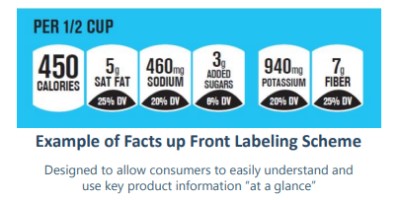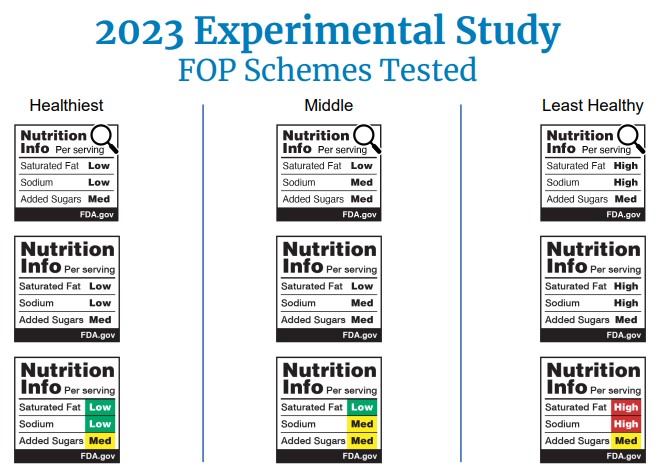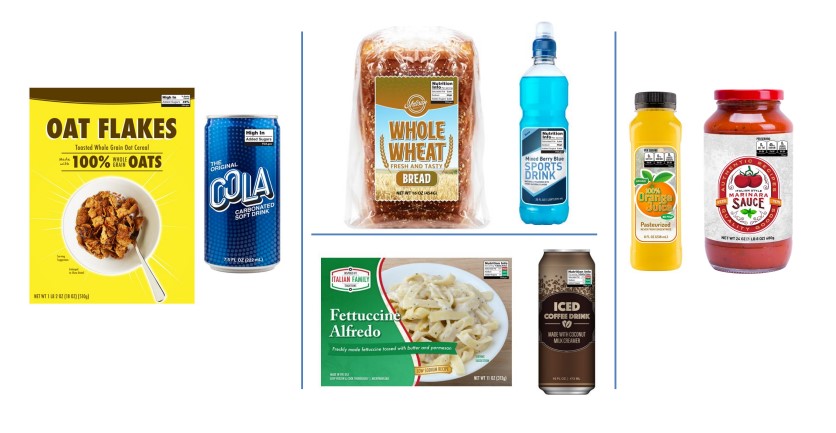The Food and Drug Administration has been testing an array of ideas for new front-of-package nutrition labeling requirements that are due out this summer intending to reduce diet-related diseases.
FDA is still in the listening stage as it conducts meetings with consumer and food industry groups on the labeling concept. Development of the labeling rules was launched in 2022 in connection with the White House Conference on Hunger, Nutrition and Health.
While speaking at a Reagan-Udall Foundation event in November on the status of the FOP update, FDA Commissioner Robert Califf said “front-of-package labeling has the potential to be similarly iconic” to the previous agency work on updates to the nutrition facts label, labeling requirements for restaurant menus, voluntary sodium targets and the definition of “healthy” claims.
Califf said front-of-package labeling requirements “can help consumers quickly and easily identify foods that can help them build a healthy eating pattern.”
FDA has been testing different labeling models and reviewing the impact of labeling schemes used in other countries.
One concept under review uses the colors, red, yellow and green to indicate relative levels of saturated fat, added sugars and sodium. Other options leave off the colors and instead note the product is “High,” “Med” or “Low” in saturated fat, added sugars and sodium.
Robin McKinnon, FDA's senior adviser for nutrition policy, said focus group research found participants were confused by the use of the colors.
McKinnon said initial focus group findings confirm “consumers prefer simple, interpretive FOP labeling schemes. And the FOP labels appear helpful for those with lower nutrition knowledge, and that FOP  complements the nutrition facts label.”
complements the nutrition facts label.”
Dana Graber — associate general counsel and senior director for legal and regulatory affairs with FMI–The Food Industry Association, which represents major grocery chains — told Agri-Pulse her industry is struggling to see how FDA’s schemes tested currently will meet the agency’s goals to empower consumers to make healthier food choices, especially since none of the current schemes include calories. Some food products already voluntarily list a condensed version of the back-of-label nutritional information.
“In our view, including calories is necessary from a public health perspective to reach the agency’s stated goals,” Graber said.
Eva Greenthal — senior policy scientist at the Center for Science in the Public Interest, a consumer advocacy group — told Agri-Pulse it appears the agency is leaning toward the front-of-package label that highlights sodium, added sugars and saturated fats as opposed to also adding other nutrients such as fiber and calcium.
She believes FDA will steer clear of a scheme that implies a warning label, such as a warning sign or octagonal symbol similar to iconography used in Latin America. Canada’s new labeling rules,  which go into effect in 2026, display a magnifying glass to highlight the nutrients of concern, and a similar approach in Brazil focuses on disclosures rather than warnings.
which go into effect in 2026, display a magnifying glass to highlight the nutrients of concern, and a similar approach in Brazil focuses on disclosures rather than warnings.
It’s easy to be “in the know” about what’s happening in Washington, D.C. Sign up for a FREE month of Agri-Pulse news! Simply click here.
“I do think it’s possible that we’ll see high-in disclosures like Canada’s,” Greenthal said of FDA’s anticipated proposal.
Mollie Van Lieu, the International Fresh Produce Association's vice president of nutrition and health, said Canada’s front-of-package labeling exempts single ingredients for all fruits and vegetables, but it would require the listing of nutrients in added sauces and dressings on many products.
It’s easy to be “in the know” about what’s happening in Washington, D.C. Sign up for a FREE month of Agri-Pulse news! Simply click here.
She said IFPA has evaluated the impact of FOP designs as it relates to the per serving versus per package identification, which is an important consideration if dressings must be identified as higher in saturated fat.
Graber said FMI believes the inclusion of “medium” can insert new confusion as it has never been defined by regulation or used in general FDA guidance regarding nutrition labeling.
“Struggling to know how to interpret a ‘medium’ designation, especially when paired with a ‘low/high’ designation, might prove challenging, particularly for those of lower nutrition literacy,” Graber said.
Color schemes also pose some concern, with the general thought that red means stop, yellow is cautionary and green means go. Graber said consumer confusion could ensue, for instance, if a loaf of whole grain bread had a red colored “added sugar” distinction, even though the food includes many positive healthy attributes.
CSPI's Greethanl said FDA already delayed action on finalizing the front-of-package labeling from December 2023 to an anticipated proposed release date of June 2024, and CSPI does not want to see it delayed further. “We’re really going to be holding FDA to that,” she said.
She expects FDA to conduct a 90-day comment window once the rule is released this summer, with another at least six months to dig into those comments. Assuming no change in administration, Greenthal projects a final rule could be released as early as February or March 2025.
 Industry pushback has been significant. Greenthal said many in the industry are trying to “stifle progress however they can” and “throwing every anti-regulatory argument at the wall and see what sticks.”
Industry pushback has been significant. Greenthal said many in the industry are trying to “stifle progress however they can” and “throwing every anti-regulatory argument at the wall and see what sticks.”
FMI is not taking an affirmative position on whether FDA has the legal authority to mandate front-of-package labeling, Graber said, but noted they “agree that there are legitimate concerns and suspect that FDA is likely going to face legal challenges based on this issue.”
“We have raised these concerns and urged the agency to work closely with their own legal counsel to ensure that valueable FDA resources are not wasted on a rule that could be subsequently struck down in court,” Graber said.
Also on FDA’s agenda this year is the finalization of the term “healthy” and potentially introducing a logo that food products could display if it met the definition of healthy.
Van Lieu said if FDA chooses to propose a healthy logo, it makes sense to do it on a similar timeline as FDA’s updates to the front-of-package label, but this could also slow all the work done if it’s trying to be done in tandem.
For more news, visit Agri-Pulse.com.


